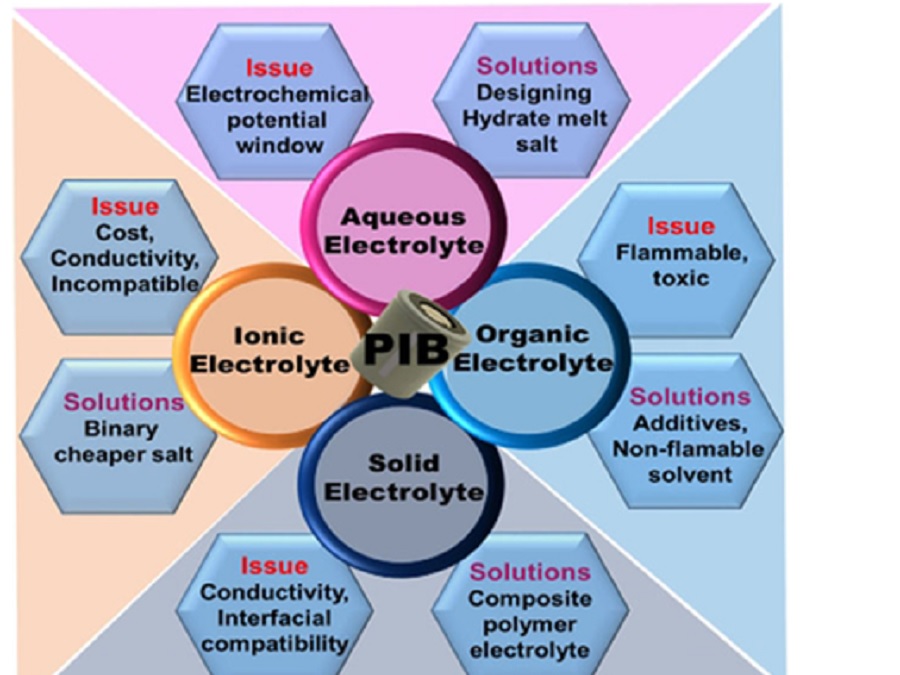Sustainable Eco-Friendly Electrolytes in Batteries
Eco-friendly electrolytes in batteries represent a significant advancement in energy storage technology aimed at reducing the environmental impact of battery production and disposal. In the modern world, batteries are essential to power our vehicles, devices, and homes. Despite its usage, its production and disposal have a severe impact on the environment. The electrolyte that conducts electricity between the electrodes in a battery is the main contributor. Traditional electrolytes are manufactured using harmful chemicals such as lead, cadmium, and mercury. Improper disposal of batteries produces severe environmental concerns. The mining process of chemicals also produces a negative impact on the environment. Therefore, a search for sustainable and eco-friendly electrolytes for batteries is of utmost importance to produce a safer environment. Eco-friendly electrolytes are renewable and recyclable materials that do not produce harmful to the environment.
Types of sustainable electrolytes
Researchers continuously devoted efforts to developing sustainable, eco-friendly electrolytes to prevent environmental issues. Sustainable electrolytes were developed to produce more sustainable batteries. Sustainable electrolytes offer more environmental benefits than traditional electrolytes. For instance, sustainable electrolytes are stable and have a longer life span that increases the performance of the battery.
Sustainable electrolytes for batteries include aqueous electrolytes, organic electrolytes, and solid-state electrolytes. Aqueous electrolytes are inexpensive, non-toxic, and easy to produce. Aqueous electrolytes are water-based electrolytes. These electrolytes are prepared from water and salt like LiCl3 or KOH. The water-based electrolytes are non-flammable, non-toxic, and relatively inexpensive. They have a lower energy density than other type of electrolytes. The lower ionic conductivity of aqueous electrolytes when compared with other types of electrolytes, renders them to limit its applications.
Organic electrolytes are prepared from organic solvents and show a higher energy density than aqueous electrolytes. The organic solvents are carbon-based compounds, such as ethylene glycol. They are non-toxic, flammable, and volatile but challenging to handle. They are more toxic than traditional mineral oil-based electrolytes and found to be expensive.
Solid-state electrolytes are prepared using polymers, and ceramics materials. They exist as solid at room temperature and that makes them safer than liquid electrolytes. Compared to organic electrolytes they are non-volatile and have high energy density. However, they are difficult to prepare and not developed as like other electrolytes. Researchers are developing new methods to increase the ionic conductivity of aqueous electrolytes and solid-state electrolytes as more flexible and durable.
Recent research
Scientists developed ionic liquids for eco-friendly electrolytes in batteries. Bio-based electrolytes are prepared from renewable materials, such as plant oils and sugars. These electrolytes are non-toxic and have a low environmental impact. Nevertheless, they have a lower energy density Ionic liquids are organic salts that are liquid at room temperature. Ionic liquids are non-toxic. They have high ionic conductivity that enables them as a promising substance for eco-friendly electrolytes.
Graphene is a 2D material that possesses excellent electrical conductivity and thermal conductivity. It is used as a promising material in the electrolyte to improve the stability and performance of batteries. It was developed at the University of Texas at Austin.
Metal-organic frameworks are porous materials that are used in electrolytes to store ions. The conductivity and stability of batteries were improved. The Scientists at the University of Cambridge developed the research work.
Recent research at the University of California developed a new aqueous electrolyte based on ionic liquids that show high conductivity over a wide range of temperatures. The University of Michigan achieved a new solid-state electrolyte based on a polymer is prepared that found to be compatible with lithium metal electrodes. Chinese Academy of Sciences developed a new bio-based electrolyte based on plant oils that can be used in high-performance batteries.
Future of eco-friendly electrolytes
The future of eco-friendly electrolytes in batteries is bright. Rapid research and new technologies are being developed to make more eco-friendly batteries. The demand for eco-friendly batteries is rapidly growing due to the increasing use of electric vehicles, portable electronics, and other devices. People are aware of the environmental impact of batteries and there will be a demand to search for more sustainable batteries. New materials are being developed that are more suitable for use as eco-friendly electrolytes. The development of eco-friendly electrolytes has the potential to impact the safety and performance of electrochemical devices. But, the development of eco-friendly electrolytes remains a challenging task for many scientists. Extensive research focused on more innovative and promising developments of non-toxic, sustainable, eco-friendly electrolytes to reduce the environmental impact.
Sources
- https://www.lifewire.com/what-can-replace-battery-electrolyte-534620#:~:text=The%20only%20electrolyte%20that%20can,substances%20are%20worse%20than%20others.
- https://www.anl.gov/article/designing-better-battery-electrolytes#:~:text=An%20electrolyte%20is%20the%20battery,chemistry%20is%20relatively%20well%2Ddefined.
- https://dragonflyenergy.com/battery-electrolyte/
- https://www.frontiersin.org/articles/10.3389/fmats.2020.00111/full
- https://www.sciencedaily.com/releases/2023/07/230707111656.htm

